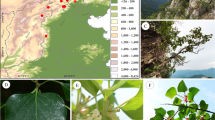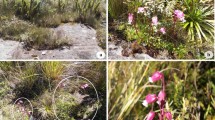Abstract
The globose cactus Ariocarpus fissuratus, known as “living rock,” is renowned for the singular morphology of its extremely cryptic single stem/taproot, which results in a resemblance of their tubercles to rocky soil. Their beauty has placed Ariocarpus among the top rated illegally traded cactus. In the Cuatro Ciénegas Basin, important populations of A. fissuratus occur. This is the only Ariocarpus out of seven species in the genus, found outside Mexico, reaching southern Texas. In order to determine the influence of sexual reproduction to the conservation of healthy populations, we studied the reproductive ecology of A. fissuratus including floral morphology and phenology, interaction with insects, and mating and breeding systems. Results indicate that floral phenology is remarkably synchronic, and it occurs from middle October to early November through a few pulses that vary in onset and duration but lasting only 5 or less days. Genders are separated within the flowers in time and space, diminishing the probability of selfing. Numerous pollen grains and nectar are produced as rewards for pollinators, a feature that suggests a xenogamous system. A. fissuratus is an outcrosser, as indicated by forced pollination treatments. Floral visitors include bees, wasps, flies, butterflies, and beetles; only solitary bees behave as pollinators. Species assemblage of bee pollinators vary between years, suggesting that functional specialization of pollinators occurs in this species. In addition, we observed a high incidence of florivory by a tenebrionid beetle. We conclude that success of sexual reproduction is critical for the conservation of this cactus, but its short flowering phenology, its outcrossing mating system and dependence on pollinators, exotic floral visitors (the possible negative effects of A. mellifera), and florivory may be caveats to the maintenance of healthy populations in this species.
Access this chapter
Tax calculation will be finalised at checkout
Purchases are for personal use only
Similar content being viewed by others
References
Arroyo-Cosultchi G, Cárdenas-Ramos D et al (2014) Desaparición de una población de Ariocarpus retusus Scheidw. por la destrucción de su hábitat en Miquihuana, Tamaulipas, México. Cact Suc Mex 59:52–63
Ávalos-Hernández O, Cano-Santana Z et al (2016) Diversity and resource use patterns of Anthophile insects in Cuatro Ciénegas, Coahuila, México. Environ Entomol 45:1386–1397
Byers DL, Meagher TR (1997) A comparison of demographic characteristics in a rare and a common species of Eupatorium. Ecol Appl 7:519–530
Cesaro AC, Barrett SCH et al (2004) An experimental evaluation of self-interference in Narcissus assoanus: functional and evolutionary implications. J Evol Biol 17:1367–1376
Cruden RW (1977) Pollen-ovule ratios: a conservative indicator of breeding systems in flowering plants. Evolution 31:32–46
Eggli U, Giorgetta M (2015) Flowering phenology and observations of the pollination biology of South American Cacti. 2. Cereus aethiops. Haseltonia 21:19–40
Fagua JC, Ackerman JD (2011) Consequences of floral visits by ants and invasive honeybees to the hummingbird-pollinated, Caribbean cactus Melocactus intortus. Plant Spec Biol 26:193–204
Gentry AH (1974) Flowering phenology and diversity in tropical Bignoniaceae. Biotropica 6:64–68
Kearns CA, Inouye DW (1993) Techniques for pollination biologists. University Press of Colorado, Boulder, CO, USA
Langley LA (2015) The pollination ecology of Sclerocactus brevihamatus ssp. tobuschii (Cactaceae) in the Edwards Plateau Region of West-Central Texas. Master Thesis. Faculty of the College of Graduate Studies. Angelo State University, TX, USA
Larson BMH, Barrett SCH (2000) A comparative analysis of pollen limitation in flowering plants. Biol J Linn Soc 69:503–520
Mancilla-Ramírez MR, Flores-Vázquez JC, Martínez-Peralta C, Aguilar-Morales G, Mandujano MC (2020) Cuatro Ciénegas as a refuge for the living rock cactus, Ariocarpus fissuratus: demographic and conservation studies. In: Mandujano MC, Pisanty I, Eguiarte LE (eds.) Plant diversity and Ecology in the Chihuahuan desert. Springer International, Cham, Switzerland
Mandujano MC, Verhulst JAM et al (2007) Population dynamics of Ariocarpus scaphirostris Bödeker (Cactaceae): evaluating the status of a threatened species. Int J Plant Sci 168:1035–1044
Mandujano MC, Carrillo-Angeles IG et al (2010) Reproductive biology of Cactaceae. In: Ramawat KG (ed) Desert plants: biology and biotechnology. Springer-Verlag. Berlin, Heidelberg, Germany, pp 198–230
Martínez-Peralta C, Mandujano MC (2011) Reproductive ecology of the endangered living rock cactus, Ariocarpus fissuratus (Cactaceae). J Torrey Bot Soc 138:145–155
Martínez-Peralta C, Mandujano MC (2016) Pollen limitation in a rare cactus with synchronous mass flowering. Haseltonia 22:2–8
Martínez-Peralta C, Márquez-Guzmán J, Mandujano MC (2014) How common is self-incompatibility across species of the herkogamous genus Ariocarpus? Am J Bot 101(3):1–9
Martínez-Peralta C et al (2018) Polinizadores de cactáceas globosas en sitios con disturbio antropogénico. In: Ramírez-Bautista A, Pineda-López R (eds) Ecología y conservación de fauna en ambientes antropizados. REFAMA, UAQ, CONACyT, Queretaro city, Queretaro, Mexico, pp 347–367
Ollerton J, Killick A et al (2007) On the many ways to be a generalist flower. Taxon 56:717–728
Olmos-Lau VR, Mandujano MC (2016) An open door for illegal trade: online sale of Strombocactus disciformis (Cactaceae). Nature Conserv 15:1–9
Ortega-Baes P, Saravia M et al (2011) Reproductive biology of Echinopsis terscheckii (Cactaceae): the role of nocturnal and diurnal pollinators. Plant Biol 13:33–40
R Core Team (2018) R: a language and environment for statistical computing. R Foundation for Statistical Computing, Vienna, Austria. https://www.R-project.org/.
Schlindwein C, Wittman D (1995) Specialized solitary bees as effective pollinators of South Brazilian species of Notocactus and Gymnocalycium (Cactaceae). Bradleya 13:25–34
Silva L, Furtado-Dias E et al (2015) Towards a more holistic research approach to plant conservation: the case of rare plants on oceanic islands. Ann Bot-London 7:1–18
Souza V, Eguiarte LE (2018) In the beginning, there was fire: Cuatro Ciénegas Basin (CCB) and the long history of life on earth. In: Souza V et al (eds) Cuatro Ciénegas ecology, natural history and microbiology. Springer, Cham, Switzerland, pp 21–33
Souza V, Eguiarte LE et al (2018) A microbial saga: how to study an unexpected hot spot of microbial biodiversity from scratch? In: Souza V et al (eds) Cuatro Ciénegas ecology, natural history and microbiology. Springer, Cham, Switzerland, pp 1–20
Vanbergen AJ et al (2013) Threats to an ecosystem service: pressures on pollinators. Front Ecol Environ 11:251–259
Walck JL et al (2001) Why is Solidago shortii narrowly endemic and S. altissima geographically widespread? A comprehensive comparative study of biological traits. J Biogeogr 28:1221–1237
Author information
Authors and Affiliations
Corresponding author
Editor information
Editors and Affiliations
Rights and permissions
Copyright information
© 2020 Springer Nature Switzerland AG
About this chapter
Cite this chapter
Martínez-Peralta, C., Jiménez-Díaz, J., Flores-Vázquez, J.C., Mandujano, M.C. (2020). Reproductive Biology and Conservation of the Living Rock Ariocarpus fissuratus. In: Mandujano, M., Pisanty, I., Eguiarte, L. (eds) Plant Diversity and Ecology in the Chihuahuan Desert. Cuatro Ciénegas Basin: An Endangered Hyperdiverse Oasis. Springer, Cham. https://doi.org/10.1007/978-3-030-44963-6_12
Download citation
DOI: https://doi.org/10.1007/978-3-030-44963-6_12
Published:
Publisher Name: Springer, Cham
Print ISBN: 978-3-030-44962-9
Online ISBN: 978-3-030-44963-6
eBook Packages: Biomedical and Life SciencesBiomedical and Life Sciences (R0)




